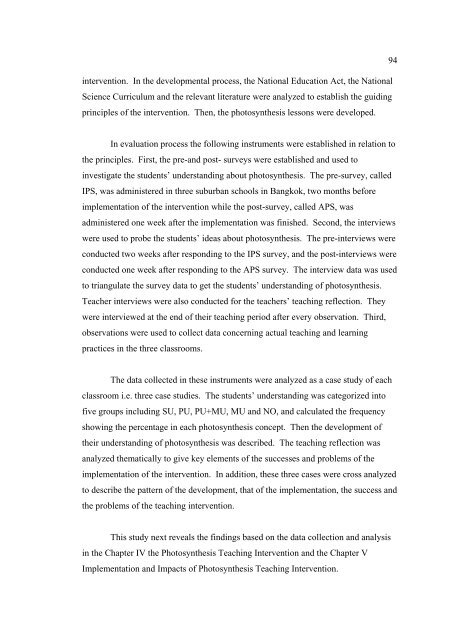an innovative approach
an innovative approach
an innovative approach
You also want an ePaper? Increase the reach of your titles
YUMPU automatically turns print PDFs into web optimized ePapers that Google loves.
intervention. In the developmental process, the National Education Act, the National<br />
Science Curriculum <strong>an</strong>d the relev<strong>an</strong>t literature were <strong>an</strong>alyzed to establish the guiding<br />
principles of the intervention. Then, the photosynthesis lessons were developed.<br />
In evaluation process the following instruments were established in relation to<br />
the principles. First, the pre-<strong>an</strong>d post- surveys were established <strong>an</strong>d used to<br />
investigate the students’ underst<strong>an</strong>ding about photosynthesis. The pre-survey, called<br />
IPS, was administered in three suburb<strong>an</strong> schools in B<strong>an</strong>gkok, two months before<br />
implementation of the intervention while the post-survey, called APS, was<br />
administered one week after the implementation was finished. Second, the interviews<br />
were used to probe the students’ ideas about photosynthesis. The pre-interviews were<br />
conducted two weeks after responding to the IPS survey, <strong>an</strong>d the post-interviews were<br />
conducted one week after responding to the APS survey. The interview data was used<br />
to tri<strong>an</strong>gulate the survey data to get the students’ underst<strong>an</strong>ding of photosynthesis.<br />
Teacher interviews were also conducted for the teachers’ teaching reflection. They<br />
were interviewed at the end of their teaching period after every observation. Third,<br />
observations were used to collect data concerning actual teaching <strong>an</strong>d learning<br />
practices in the three classrooms.<br />
The data collected in these instruments were <strong>an</strong>alyzed as a case study of each<br />
classroom i.e. three case studies. The students’ underst<strong>an</strong>ding was categorized into<br />
five groups including SU, PU, PU+MU, MU <strong>an</strong>d NO, <strong>an</strong>d calculated the frequency<br />
showing the percentage in each photosynthesis concept. Then the development of<br />
their underst<strong>an</strong>ding of photosynthesis was described. The teaching reflection was<br />
<strong>an</strong>alyzed thematically to give key elements of the successes <strong>an</strong>d problems of the<br />
implementation of the intervention. In addition, these three cases were cross <strong>an</strong>alyzed<br />
to describe the pattern of the development, that of the implementation, the success <strong>an</strong>d<br />
the problems of the teaching intervention.<br />
This study next reveals the findings based on the data collection <strong>an</strong>d <strong>an</strong>alysis<br />
in the Chapter IV the Photosynthesis Teaching Intervention <strong>an</strong>d the Chapter V<br />
Implementation <strong>an</strong>d Impacts of Photosynthesis Teaching Intervention.<br />
94
















